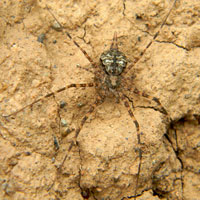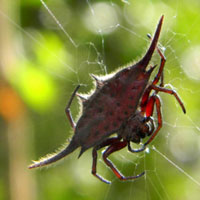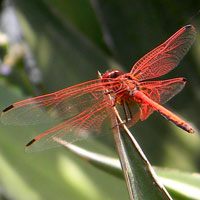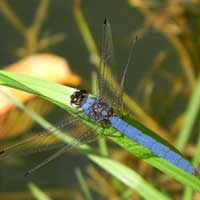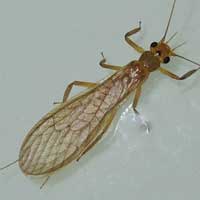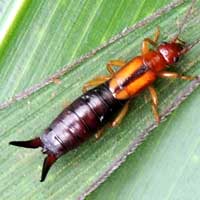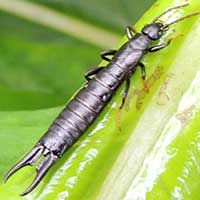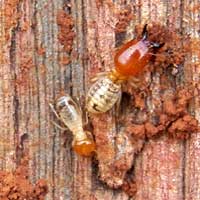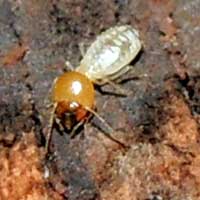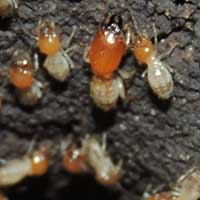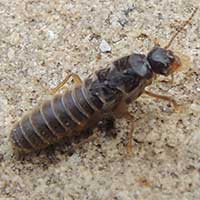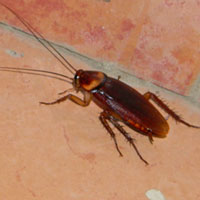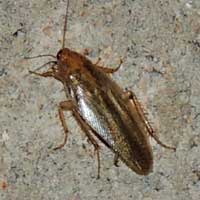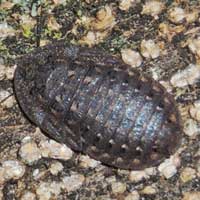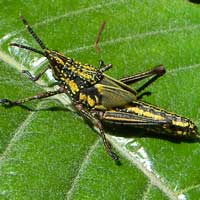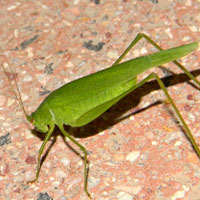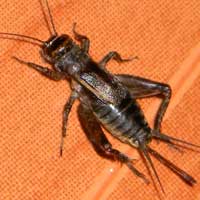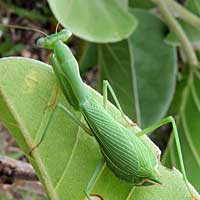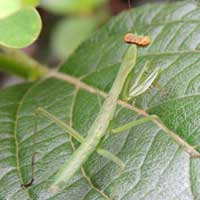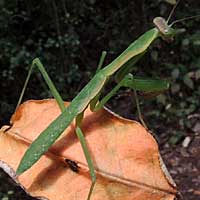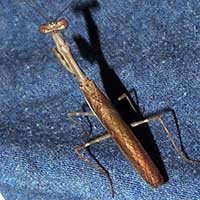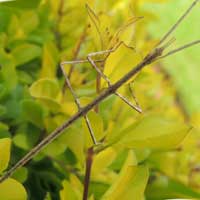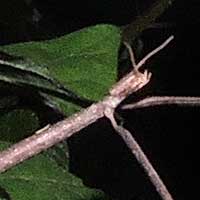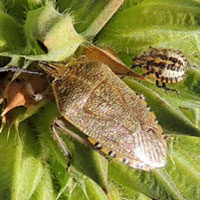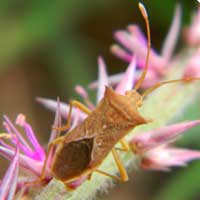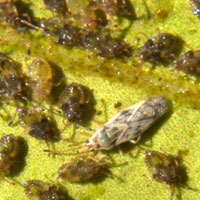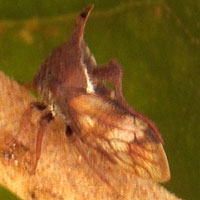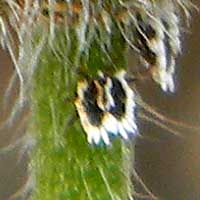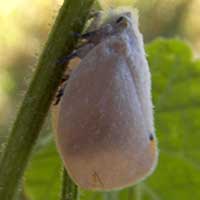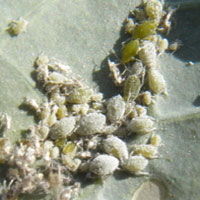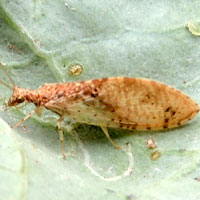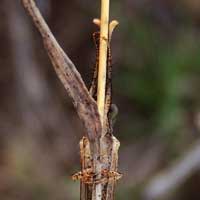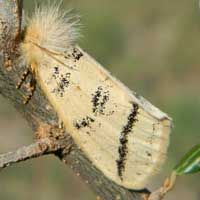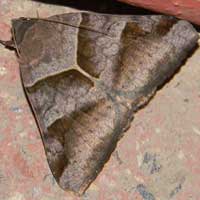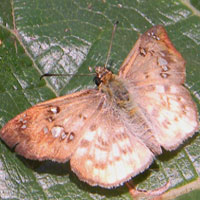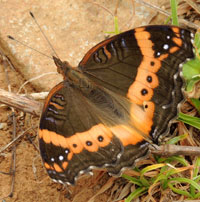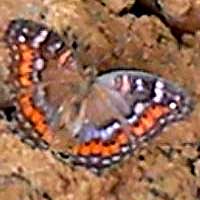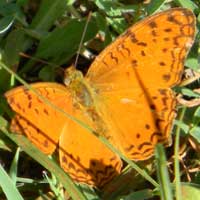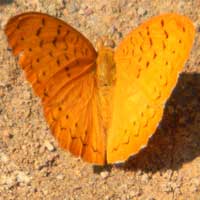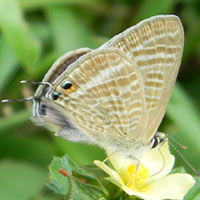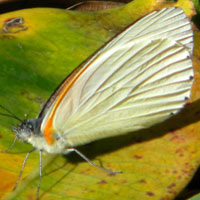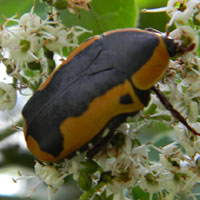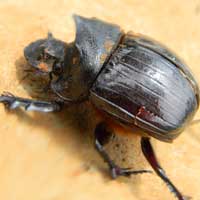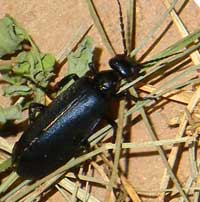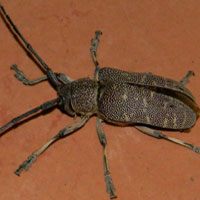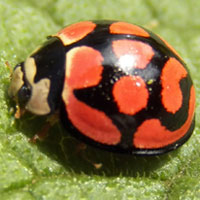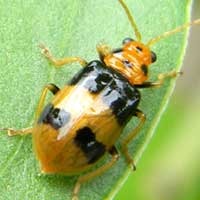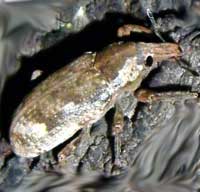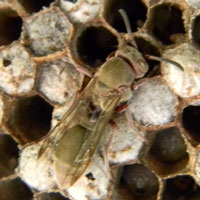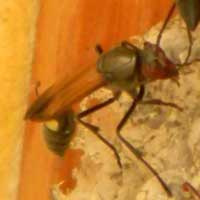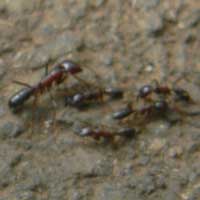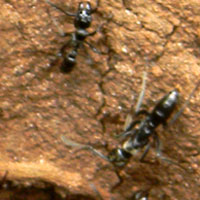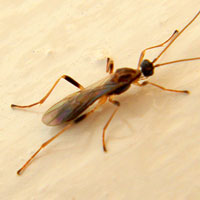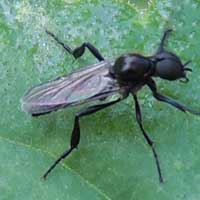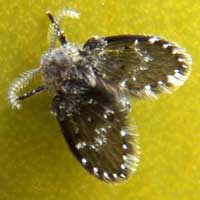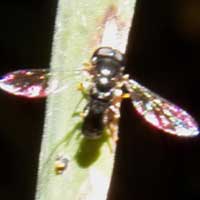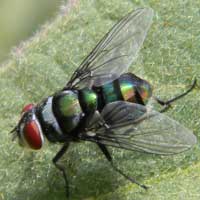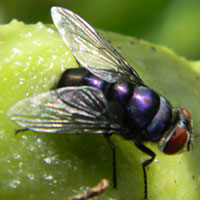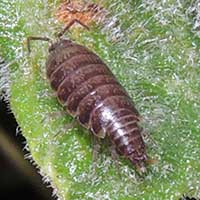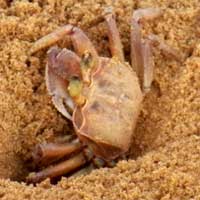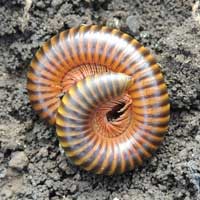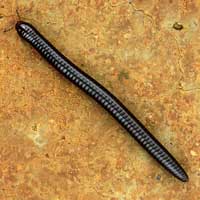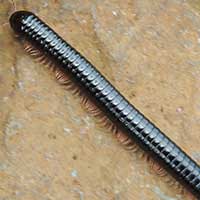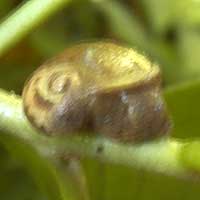A nearly invisible web directly against the substrate surrounds a spider that also blends in with camouflage. Two long spinnerettes.
A colorful spider with conspicuous body armor. Sits at the center of an orb web erected between branches of vegetation.
Red dragonfly with unmarked wings' but with veins red and a black stigma near forewing tip.
Sky blue dragonfly perches with wings set forward. Sometimes commonly called set-wing.
This is an adult and primarily nocturnal. The immature stage is aquatic in flowing water.
Feeds largely as scavenger on rotting plant material. Pincer like cerci at posterior of abdomen.
The pincers are not dangerous to people nor can this insect cause any harm.
Builds cover of mud-like carton over exposed wood before chewing and converting to more termites. Soldiers have mighty pincer mandibles.
The head of this termite has beak-like nozzle. Feeds on wood with direct or indirect contact with soil.
Two to four cm diameter entrances at ground level with soldiers guarding.
Winged termites once they have flown and mated loose their wings and then must soon dig into the soil and attempt to establish a new colony.
This large nocturnal insect is common to abundant in and around human habitations in tropical and subtropical areas worldwide.
This is one of the common cockroaches likely to be seen in and around human habitations.
Adult female lacks wings and is able to press itself close to a smooth bark surface. Nocturnal.
This grasshopper was found at 2400 m in Rift Valley. Its bright colors indicate toxicity to insect-eating birds.
Leaf like and usually difficult to see. Comes to lights at night. Long fine antennae
Field crickets of several different species are found in temperate, mesic habitats the World over.
This large praying mantis should be capable of capturing large insects like moths, butterflies and bees.
The mantis has large eyes on a swivel-head and a pair of grasping legs held prayer-like. Adults of many kinds have wings. Voracious predators.
The mantis has large eyes on a swivel-head and a pair of grasping legs held prayer-like. Adults of many kinds have wings. Voracious predators.
This praying mantis was attracted to lights at night which could spell trouble for this predator's survival.
Usually impossible to find until they are knocked from vegetation. This one has short antennae like Baculum.
Usually impossible to find until they are knocked from vegetation. This one feeds and moves about at night and is also like Baculum.
The outline of the bug suggests a pentagon shape. Mouthparts are long and sharp for inserting down into plant tissue.
Most leaf-footed bugs have a leaf-like process on the third legs - this one is an exception. Many kinds that feed on plants.
Small insects that usually live in groups on undersides of leaves. Some have lacy fringe on thorax. Host of this one is African Olive, Olea.
What looks like a thorn on a plant turns out to be a hopping bug! Many species in wide array of colors and shapes.
Clumsy, barely mobile bugs with a cottony border found on growing points of plants and usually with ant guards.
Bright white velvety wings folded into tent. Hops when disturbed.
Slow moving blue-green insects that form colonies on coles such as cabbage and mustard greens. Small, medium and larger bugs together sometimes with wings.
Small, delicate insect with net-veined wings and a light brown coloration. Long filamentous antennae.
Barely the eyes and the antennae are visible in this shot. Net-veins suggest a butterfly x dragonfly cross.
Many tiger moths are brightly colored or are otherwise not camouflaged. Often distasteful or even toxic for birds to eat.
When this moth rests on a tree trunk it disappears from view by camouflage.
Skippers have clubs at antennae tips but also a small hooked appendage off the club.
Medium-sized butterfly with dark chocolate brown disc encircled by two shades of yellow-orange bands. Wingspan about 5 cm.
Medium-sized butterfly marked with concentric blue, orange and white on a dark background.
Wing span of about 5 cm of bright orange marked with black spots and filigree border. Common and widespread.
So far a precise identification of this butterfly eludes me. It might be Pseudargynnis.
There are many kinds of blues mostly less than 25 mm across. Top is blue-gray and underside is a chevron pattern of gray and blue.
White, yellow and orange butterflies with distinct black dots arrayed along the wing margins. Several species.
Sharply marked large beetles with rather pointed prothorax and head. Conspicuous at flowers. Grubs live in soil.
Large dark brown or black beetles roll grazing animal dung into balls. Males have fabulous horns. This one is a female.
Dark blue, almost black. Elytra (wing covers) soft. Pronotum narrower than head and wings. Seen often on flowers.
Robust beetles with long, stout antennae. Larvae tunnel inside tree branches.
Many lady beetles are gaily colored and because many control pests important to man they are popular insects. This one can be orange or red with black spots.
Colorful, medium-sized beetles often seen chewing leaves.
Thousands of kinds of weevils inhabit farms, forests and grasslands of Kenya. Many have larvae (grubs) that live under the soil.
Many kinds of paper wasps can be found with nests of paper placed under shelter offered by buildings.
Some paper wasp species are aggressive others not. This one seems docile. Dark brown w/ bright yellow spots on abdomen.
Usually seen in dense columns of fast moving ants. Painful sting. Mixed sizes in the column.
Some are called bullet ants due to shape and pain of sting. Cylindrical shape. This one from Saiwa Swamp.
These small, delicate wasps do not sting; instead they are the farmer's ally by killing pest insects.
The eyes are very large, filling the dorsum of the head. Enlarged pronotum. Observed at Kitale.
These small flies look like tiny moths with feathery wings held flat when sitting. White spotting. Usually near wastewater drainage.
This little fly, about 3mm, has some peculiar morphology that might clue a dipterist.
A marvelously iridescent fly of jade and gold. The larva, or maggot, lives in garbage or carrion. Such is the economy of Nature.
This one is deep cobalt blue. The larva, or maggot, lives in garbage or carrion, maybe of a different condition or type. Such is the variety in Nature.
An arthropod yes, but not an insect. Too many legs and does not have 3 main body segments. A terrestrial crustacean.
Most crustaceans like this crab live in marine environments and a large number are fresh water aquatic.
A threatened millipede contracts into a tight spiral. This large species is banded orange and chocolate.
There are two pairs of legs on each of the many body segments. This specimen is about 80 mm long.
This large milipede is from the southern slopes of Mt. Kenya and is also about 80 mm long.
No, this is not an insect! But for now this terrestrial mollusk is indexed here.
